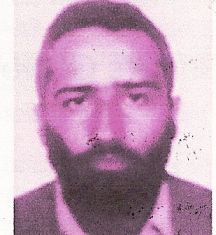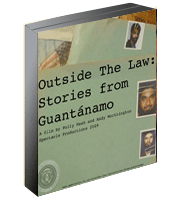Guantánamo suicides: so who’s telling the truth?
24.10.07
The grim story of the Guantánamo suicides –- the deaths of three men, Ali al-Salami, Mani al-Utaybi and Yasser al-Zahrani in June 2006, and another, Abdul Rahman al-Amri, in May this year –- took another turn last week, when, in the absence of the Naval Criminal Investigative Service’s long-awaited report into the deaths, Navy Capt. Patrick McCarthy, the senior lawyer on Guantánamo’s management team, spoke out in an interview, declaring that all four men had killed themselves with “craftily fashioned nooses.”

Yasser al-Zahrani.
Speaking as the ridiculous saga of smuggled underwear continued to make waves in the media, McCarthy attempted to highlight the seriousness of the administration’s response to ludicrous claims that underwear had been surreptitiously delivered to two detainees, saying, “There was a Speedo in the camp and someone can hang himself with it. The Speedo also has a drawstring on it. The drawstring can be used to tie the Speedo, the noose apparatus up onto a vent.’”
Breaking with protocol, McCarthy also spoke about the deaths in Guantánamo, claiming that he had personally seen “all four men dead –- each one hanging –- and that the first three men had used sling-style nooses.” This is the first time that a representative of the US military has spoken openly about the death of al-Amri, who, McCarthy said, had fashioned “a string type of noose” to kill himself, although Carol Rosenberg of the Miami Herald, who reported the story, added that “he did not elaborate.”
The circumstances of the men’s deaths have long been contentious. After the 2006 suicides, many former detainees who had known the men spoke of their shock and incredulity at the news. Tarek Dergoul, a British detainee released in 2004, spent three weeks in a cell beside al-Utaybi. He recalled “his indefatigable spirit and defiance,” and pointed out that he was “always on the forefront of trying to get our rights.” He had similar recollections of al-Zahrani, describing him as ”always optimistic” and “defiant,” and adding that he “was always there to stand up for his brothers when he saw injustices being carried out.”
In a press release shortly after the deaths were announced, former detainees, including the nine released British nationals, “poured scorn” on allegations that the deaths were suicides, and claimed that they were “almost certainly accidental killings caused by excessive force” on the part of the guards. A note of caution, however, was provided by British resident Shaker Aamer, who was told by a guard in Camp Echo, an isolation block where they were held for some of the time (and where Aamer himself has now spent two years and two months without any meaningful human company), “They have lost hope in life. They have no hope in their eyes. They are ghosts, and they want to die. No food will keep them alive now. Even with four feeds a day, these men get diarrhea from any protein which goes right through them.”
As the NCIS has, inexplicably, yet to conclude its investigation, it’s impossible to know at this point what the official conclusion will be. Clearly, the military has stepped back from its initial response, when the prison’s commander, Rear Admiral Harry Harris, attracted worldwide condemnation for claiming that the men’s deaths were “an act of asymmetric warfare.” As was revealed in documents released by the Pentagon earlier this year, however, which described, in minute and numbing detail, the weights of all the detainees in Guantánamo throughout their detention, all three men had been long-term hunger strikers, and two had been strapped into restraint chairs and force-fed until days before their deaths. This deliberately painful process, designed to “break” the strikers, is, it should be noted, illegal according to internationally recognized rules regarding the rights of competent prisoners to undertake hunger strikes, but in this, as with almost everything else at Guantánamo, the administration regards itself as above the law.
Al-Zahrani was force-fed several times a week from the start of October 2005, and daily from November 14 to January 18, 2006, during which time his weight fluctuated between 87.5 lbs and 98.5 lbs. Al-Utaybi, who weighed just 89 lbs at various times in September and October 2005, was force-fed several times a week from July to September 2005, and daily from December 24 to February 7, 2006. Crucially, his force-feeding began again on May 30, 2006, and continued until the records ended on June 6, just three days before his death.
Even more disturbing is the chronicle of al-Salami’s hunger strike. Although his weight loss did not appear as dramatic –- he weighed a healthy 172 lbs on arrival in Guantánamo –- he lost nearly a third of his body weight at the most severe point of his hunger strike, when his weight dropped to 120 lbs. What was particularly disturbing about his weight report, however, was the revelation that he was force-fed daily from January 11, 2006 until, as with al-Utaybi, the records ended on June 6, just three days before his death.

Ali al-Salami.
Given this information, it’s unsurprising that those who are suspicious of the administration –- and of Capt. McCarthy’s supposed frontline recollections –- might conclude, as the former detainees suggested, that it would not have taken much on the part of the authorities to finish off three men who had persistently aroused the wrath of the administration through their lack of cooperation and their hunger strikes, and who were all critically weak at the time of their deaths.
As for al-Amri’s death, Carol Rosenberg noted that suspicions over the circumstances of his death have been exacerbated by the fact that he died in Camp Five, one of the prison’s maximum security blocks. She explained that “prison camp tours for media and distinguished visitors emphasize that Camp Five is designed with suicide proofing such as towel hooks that won’t bear the weight of a detainee, to prevent him from hanging himself,” and that, moreover, “the tours emphasize that each captive, housed in a single-occupancy cell, is under constant Military Police and electronic monitoring, which means a guard is supposed to look in on him at least every three minutes.”
An even more critical approach to al-Amri’s death was presented by lawyer Candace Gorman, who reported last week on a visit in July to one of her clients, Abdul Hamid al-Ghizzawi. A Libyan shopkeeper, who is married to an Afghan woman and has a child that he has not seen for six years, al-Ghizzawi was “visibly shaken” on meeting Gorman, and immediately told her of his “despair” over al-Amri’s death. As Gorman described it, “Al-Ghizzawi knew that Amri had been suffering from Hepatitis B and tuberculosis, the same two conditions from which he himself suffers. Like al-Ghizzawi, Amri had not been treated for his illnesses. Al-Ghizzawi, now so sick he can barely walk, told me that Amri, too, had been ill and then, suddenly, he was dead.” Al-Ghizzawi’s conclusion, as described on Gorman’s website, was that al-Amri had actually died of “medical neglect,” although she also noted that al-Ghizzawi “had mentioned that Amri had engaged in hunger strikes in the past but had stopped a long time ago because of his health.”
While this was correct, one can only wonder what the effect on al-Amri’s health had been of his participation in the mass hunger strike in the fall of 2005, when his weight, which had been 150 lbs when he arrived in Guantánamo in February 2002, dropped at one point to just 88.5 lbs, and he was force-fed, often several times a week, from October 2005 to January 2006. Like the three men who died in June 2006, al-Amri was a non-cooperative detainee, who had refused to take part in any of the sham tribunals and administrative reviews at Guantánamo, and it does not take much imagination to conclude that, with his severe and untreated illnesses, he, like the three men the year before, could actually have died not through medical neglect, but as another “accidental killing caused by excessive force” on the part of the guards.
I do not profess to know the truth of the matter one way or the other, but in revisiting the stories of these men’s deaths I hope to have demonstrated that, far from clearing the air, Capt. McCarthy’s comments have, ironically, served only to revive Guantánamo’s most tragic stories, which, presumably, the rest of the administration hoped had been forgotten. Sixteen months after the first deaths, and four months after the additional death that caused such distress to Abdul Hamid al-Ghizzawi, it is surely time for the investigators of the Naval Criminal Investigative Service to deliver their verdict.
 For more on the deaths in 2006 at Guantánamo, including the feebleness of the allegations against the men, and more on the hunger strikes and other suicide attempts, see my newly published book The Guantánamo Files: The Stories of the 774 Detainees in America’s Illegal Prison (published by Pluto Press, distributed by Macmillan in the US, and available from Amazon — click on the following for the US and the UK). To receive new articles in your inbox, please subscribe to my RSS feed.
For more on the deaths in 2006 at Guantánamo, including the feebleness of the allegations against the men, and more on the hunger strikes and other suicide attempts, see my newly published book The Guantánamo Files: The Stories of the 774 Detainees in America’s Illegal Prison (published by Pluto Press, distributed by Macmillan in the US, and available from Amazon — click on the following for the US and the UK). To receive new articles in your inbox, please subscribe to my RSS feed.
As published on CounterPunch and American Torture. An edited version also appeared on the Huffington Post.
Note: The Pentagon referred to Mani al-Utaybi as Mana al-Tabi, and to Ali al-Salami as Ali Abdullah Ahmed. Al-Utaybi’s name was also transliterated in some reports as Manei al-Oteibi, and al-Salami was also known as Salah al-Salami.
For a sequence of articles dealing with the hunger strikes at Guantánamo, see Shaker Aamer, A South London Man in Guantánamo: The Children Speak (July 2007), Guantánamo: al-Jazeera cameraman Sami al-Haj fears that he will die (September 2007), The long suffering of Mohammed al-Amin, a Mauritanian teenager sent home from Guantánamo (October 2007), Innocents and Foot Soldiers: The Stories of the 14 Saudis Just Released From Guantánamo (Yousef al-Shehri and Murtadha Makram) (November 2007), A letter from Guantánamo (by Al-Jazeera cameraman Sami al-Haj) (January 2008), A Chinese Muslim’s desperate plea from Guantánamo (March 2008), Sami al-Haj: the banned torture pictures of a journalist in Guantánamo (April 2008), The forgotten anniversary of a Guantánamo suicide (May 2008), Binyam Mohamed embarks on hunger strike to protest Guantánamo charges (June 2008), Second anniversary of triple suicide at Guantánamo (June 2008), Guantánamo Suicide Report: Truth or Travesty? (August 2008), Seven Years Of Guantánamo, And A Call For Justice At Bagram (January 2009), British torture victim Binyam Mohamed to be released from Guantánamo (January 2009), Don’t Forget Guantánamo (February 2009), Who’s Running Guantánamo? (February 2009), Obama’s “Humane” Guantánamo Is A Bitter Joke (February 2009), Forgotten in Guantánamo: British resident Shaker Aamer (March 2009), Guantánamo’s Long-Term Hunger Striker Should Be Sent Home (March 2009). Also see the following online chapters of The Guantánamo Files: Website Extras 2 (Ahmed Kuman, Mohammed Haidel), Website Extras 3 (Abdullah al-Yafi, Abdul Rahman Shalabi), Website Extras 4 (Bakri al-Samiri, Murtadha Makram), Website Extras 5 (Ali Mohsen Salih, Ali Yahya al-Raimi, Abu Bakr Alahdal, Tarek Baada, Abdul al-Razzaq Salih).












 Who's still at Guantánamo?
Who's still at Guantánamo?

10 Responses
Andy Worthington says...
After this article was published on Counterpunch, I received the following comments:
John Walsh, from Massachusetts, wrote to say, “Your Counterpunch piece on the Guantánamo suicides today was superb. Keep up the good work.”
Ronald Dion wrote from San Diego: “Just read your recent, disturbing piece: ‘The Guantánamo Suicides: Who is Telling the Truth?’” He added, regarding my book The Guantánamo Files, “There are many books recently published and, I am sure, forthcoming, one hardly knows where to start in studying the atrocity known as the Iraq War. Not having a great deal of money and very limited ability to absorb vast quantities of information I usually restrict my readings to shorter works. Nevertheless, I want to compliment your efforts to keep us informed. The MSM surely will not do it if people like you do not.”
And finally, Joe Fougerousse wrote from Illinois to say, “Oh yes you do know the truth of the matter! Those men were tortured and murdered by their American captors. One doesn’t need investigations and reports to know the obvious. The fact that they died in custody is evidence enough.”
...on October 25th, 2007 at 12:28 pm
True Blue Liberal » Guantánamo Suicides: So Who’s Telling The Truth? says...
[…] Read more Suicides […]
...on October 25th, 2007 at 12:47 pm
Andy Worthington says...
After I replied to Ronald Dion, he sent another comment: “Of course, you would be out of the US. Not many in the US have the courage or commitment to write as you do. I’ve taken a brief look at your website and will peruse it as I muster energy and stamina. It is heavy stuff that tries me. Suffering as I do from the effects of cumulative stress and PTSD I have to measure my exposure carefully. Yet, I am determined to keep as well informed as possible. I do not know to what end (if any) this may serve but am convinced that one can do nothing if one operates in ignorance. Thank you once again for your efforts and the skills you have put much energy into developing.”
And this just in from Tom Caulder: “I just now read ‘The Guantánamo Suicides: Who is Telling the Truth?’ Great writing but a topic that Americans do not care about because they have no control over anything the US does. The US is like an earthquake — uncontrolled. Voting lends the US legitimacy. So a vote for war under Republicans is different from a war under Democrats? That’s why I am trying to get some interest in a campaign to not vote. The US will slowly disappear. Not voting is a concept everyone can get their minds around. The idea will either take off or not. Your help would be appreciated. Talk it up.”
...on November 1st, 2007 at 1:16 am
GUANTANAMO CONCENTRATION CAMP: CHINESE BROTHER WRITES TO US « A Soldier’s Heart says...
[…] and external organs and our arms and legs. Or is it necessary for a few Turkistanis to die, as happened in the past here in this jail, in order to gain others’ attention and their concern towards our matter? […]
...on March 28th, 2008 at 3:11 pm
Abdulghappar’s Letter From Guantánamo « Shia Islam says...
[…] and external organs and our arms and legs. Or is it necessary for a few Turkistanis to die, as happened in the past here in this jail, in order to gain others’ attention and their concern towards our matter? […]
...on March 29th, 2008 at 4:34 am
Linda G. Richard says...
Excellent piece! Thank you Andy, for bringing this issue to everyone’s attention. And thanks for the wonderful book! I use it very very often researching detainees.
...on April 27th, 2008 at 12:03 am
Guantánamo Suicide Report:Truth or Travesty? « HEART TALKS says...
[…] ‘vision,’ in which three of them had to die for the rest to be freed.” As I also reported in a previous article, Aamer also seemed to endorse the view that the men had committed suicide, […]
...on August 29th, 2008 at 2:55 am
The Third Anniversary of a Death in Guantánamo 31.5.10 « freedetainees.org says...
[…] explanation about the circumstances of his death that has ever been provided by the authorities came in October 2007, when Navy Capt. Patrick McCarthy, the senior lawyer on Guantánamo’s management team, declared […]
...on June 2nd, 2010 at 9:15 pm
Guantanamo: Alle Zeichen deuten auf Ermordung eines Gefangenen « Ticker says...
[…] men on June 9, 2006 — all long-term hunger strikers, like Abdul Rahman al-Amri — have long been contentious, and became more so in January this year when, in a compelling article in Harper’s Magazine, […]
...on June 9th, 2010 at 1:16 pm
Suicide or Murder at Guantanamo? | STATESMAN SENTINEL says...
[…] men on June 9, 2006 — all long-term hunger strikers, like Abdul Rahman al-Amri — have long been contentious, and became more so in January this year when, in a compelling article in Harper’s Magazine, […]
...on April 13th, 2011 at 2:18 am